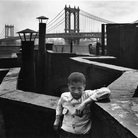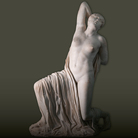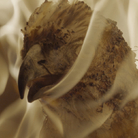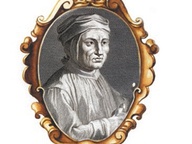Wunderkammer. Studi, scoperte, restauri per il ‘‘Grande Correr’’

V. Carpaccio, Madonna con il bambino, Wunderkammer. Studi, scoperte, restauri per il ‘‘Grande Correr’’
Dal 17 April 2013 al 31 March 2014
Venezia
Luogo: Museo Correr
Indirizzo: Piazza San Marco
Orari: Dal 1 Aprile al 31 Ottobre: 10-19 (biglietteria 10-18). Dal 1 Novembre al 31 Marzo: 10-17 (biglietteria 10-16). Chiuso 25 Dicembre e 1 Gennaio.
Costo del biglietto: intero €16, ridotto €8, scuole €5,50
Telefono per informazioni: 848082000
E-Mail info: info@fmcvenezia.it
Sito ufficiale: http://correr.visitmuve.it/
Nel 2013 nove sale al primo piano del Museo Correr sono state oggetto di un riallestimento, per cui è stata ricostruita una sorprendente “collezione delle meraviglie”. Oltre 300 le opere delle ricchissime collezioni civiche veneziane sono ora inserite nel percorso espositivo del Museo Correr, oggetto di uno specifico riallestimento, che rievoca il fascino di una possibile “Wunderkammer” lagunare.
Questo allestimento rivela i risultati della silenziosa e continua opera di catalogazione, studio e restauro delle raccolte. Un progetto che aggiunge un tassello ulteriore – dopo il restauro delle Stanze di Sissi – al programma di recupero e valorizzazione e al progetto di revisione dei percorsi del Museo affacciato su Piazza San Marco, per un “Grande Correr”.
Teodoro Correr, artefice del nucleo più rilevante delle raccolte civiche veneziane, è ricordato nella prima sala con il ritratto e i disegni del suo palazzetto sul Canal Grande a San Zandegolà. Inoltre, la raccolta dei dipinti Correr provenienti da precedenti antiche collezioni, registra con viva immediatezza il gusto veneziano. Una sala è poi interamente dedicata a oggetti d’arte sacra, tra cui troviamo, oltre a uno straordinario dente di narvalo figurato, due dei quattro arazzi provenienti da Santa Maria degli Angeli a Murano.
Superba è la sala che riunisce ed espone, per la prima volta, un piccolo e inedito “Dio padre” di Lorenzo Lotto, uno straordinario “Ritratto di Ferrante d’Avalos” che la tradizione voleva addirittura di Leonardo, uno struggente disegno con “Sant’Anna” di Dürer e tre recenti attribuzioni a Vittore Carpaccio: una “Madonna con il Bambino” (1487 ca.), una “Pietà” (1487-’90 ca.) di straordinaria intensità emotiva e poetica, e l’eccezionale “Ritratto del doge Leonardo Loredan” (1505 ca.). Si trovano poi nel percorso di visita, dipinti su tavola di provenienza nordica, come il pregevole “Salvator Mundi” assegnato a Quentin Metsys e bottega (1495 ca.), e quadri singolari ancora da approfondire, come il curioso “Ritratto di Bernardo Bergonzi” che parrebbe opera del bolognese Prospero Fontana.
Ci sono poi rarità come il bracciale “porta sali” fatto con semi d’albicocca e testimonianze della passione e del gusto per l’Antico tra i colti patrizi veneziani del Cinquecento, rappresentate da monete e gemme greche o romane e dalle loro riproduzioni rinascimentali. I magistrali metalli realizzati a Venezia da Orazio Fortezza, lo spettacolare Stipo Venier di provenienza tedesca, i preziosi altaroli-reliquari per la devozione privata si affiancano al Servizio Correr, realizzato nel 1520 ca. da Nicola da Urbino, capolavoro della maiolica rinascimentale tra i più noti e importanti in assoluto.
Notevole anche la selezione di bronzetti e placchette, che mostra opere delle officine di Padova e Venezia dalla seconda metà del Quattrocento al primo Seicento, con i grandi nomi della produzione bronzistica e le loro botteghe: Andrea Briosco detto il Riccio, Savero Calzetta da Ravenna, Tiziano Aspetti. Tra le medaglie spiccano noti esemplari di rara qualità dovuti a Pisanello, Matteo de’ Pasti, Gentile Bellini.
Infine, nell’ultima sala, sono esposti “L’arrivo a Venezia di Ercole I d’Este duca di Ferrara“, attribuito a Lazzaro Bastiani, la grande xilografia di Tiziano Vecellio che rievoca “La sommersione del Faraone nelle acque del Mar Rosso” e quella che è forse la più nota veduta prospettica a volo d’uccello di Venezia: la xilografia di Jacopo de Barbari degli inizi del XVI secolo, composta da sei fogli di carta giuntati.
Questo allestimento rivela i risultati della silenziosa e continua opera di catalogazione, studio e restauro delle raccolte. Un progetto che aggiunge un tassello ulteriore – dopo il restauro delle Stanze di Sissi – al programma di recupero e valorizzazione e al progetto di revisione dei percorsi del Museo affacciato su Piazza San Marco, per un “Grande Correr”.
Teodoro Correr, artefice del nucleo più rilevante delle raccolte civiche veneziane, è ricordato nella prima sala con il ritratto e i disegni del suo palazzetto sul Canal Grande a San Zandegolà. Inoltre, la raccolta dei dipinti Correr provenienti da precedenti antiche collezioni, registra con viva immediatezza il gusto veneziano. Una sala è poi interamente dedicata a oggetti d’arte sacra, tra cui troviamo, oltre a uno straordinario dente di narvalo figurato, due dei quattro arazzi provenienti da Santa Maria degli Angeli a Murano.
Superba è la sala che riunisce ed espone, per la prima volta, un piccolo e inedito “Dio padre” di Lorenzo Lotto, uno straordinario “Ritratto di Ferrante d’Avalos” che la tradizione voleva addirittura di Leonardo, uno struggente disegno con “Sant’Anna” di Dürer e tre recenti attribuzioni a Vittore Carpaccio: una “Madonna con il Bambino” (1487 ca.), una “Pietà” (1487-’90 ca.) di straordinaria intensità emotiva e poetica, e l’eccezionale “Ritratto del doge Leonardo Loredan” (1505 ca.). Si trovano poi nel percorso di visita, dipinti su tavola di provenienza nordica, come il pregevole “Salvator Mundi” assegnato a Quentin Metsys e bottega (1495 ca.), e quadri singolari ancora da approfondire, come il curioso “Ritratto di Bernardo Bergonzi” che parrebbe opera del bolognese Prospero Fontana.
Ci sono poi rarità come il bracciale “porta sali” fatto con semi d’albicocca e testimonianze della passione e del gusto per l’Antico tra i colti patrizi veneziani del Cinquecento, rappresentate da monete e gemme greche o romane e dalle loro riproduzioni rinascimentali. I magistrali metalli realizzati a Venezia da Orazio Fortezza, lo spettacolare Stipo Venier di provenienza tedesca, i preziosi altaroli-reliquari per la devozione privata si affiancano al Servizio Correr, realizzato nel 1520 ca. da Nicola da Urbino, capolavoro della maiolica rinascimentale tra i più noti e importanti in assoluto.
Notevole anche la selezione di bronzetti e placchette, che mostra opere delle officine di Padova e Venezia dalla seconda metà del Quattrocento al primo Seicento, con i grandi nomi della produzione bronzistica e le loro botteghe: Andrea Briosco detto il Riccio, Savero Calzetta da Ravenna, Tiziano Aspetti. Tra le medaglie spiccano noti esemplari di rara qualità dovuti a Pisanello, Matteo de’ Pasti, Gentile Bellini.
Infine, nell’ultima sala, sono esposti “L’arrivo a Venezia di Ercole I d’Este duca di Ferrara“, attribuito a Lazzaro Bastiani, la grande xilografia di Tiziano Vecellio che rievoca “La sommersione del Faraone nelle acque del Mar Rosso” e quella che è forse la più nota veduta prospettica a volo d’uccello di Venezia: la xilografia di Jacopo de Barbari degli inizi del XVI secolo, composta da sei fogli di carta giuntati.
SCARICA IL COMUNICATO IN PDF
COMMENTI

-
 Dal 2 December 2025 al 19 February 2026
Milano | Centro Culturale di Milano
Dal 2 December 2025 al 19 February 2026
Milano | Centro Culturale di Milano
Walter Rosenblum. Il mondo e la tenerezza
-
 Dal 30 November 2025 al 12 April 2026
Gallarate | Museo MA*GA
Dal 30 November 2025 al 12 April 2026
Gallarate | Museo MA*GA
Kandinsky e l’Italia
-
 Dal 29 November 2025 al 12 April 2026
Roma | Musei Capitolini
Dal 29 November 2025 al 12 April 2026
Roma | Musei Capitolini
La Grecia a Roma
-
 Dal 22 November 2025 al 3 May 2026
Torino | Sale Chiablese dei Musei Reali
Dal 22 November 2025 al 3 May 2026
Torino | Sale Chiablese dei Musei Reali
Orazio Gentileschi. Un pittore in viaggio
-
 Dal 20 November 2025 al 25 January 2026
Firenze | Palazzo Strozzi
Dal 20 November 2025 al 25 January 2026
Firenze | Palazzo Strozzi
Andro Eradze. Bones of Tomorrow
-
 Dal 21 November 2025 al 28 March 2026
Cuneo | Complesso Monumentale di San Francesco
Dal 21 November 2025 al 28 March 2026
Cuneo | Complesso Monumentale di San Francesco
La Galleria Borghese. Da Raffaello a Bernini. Storia di una collezione


